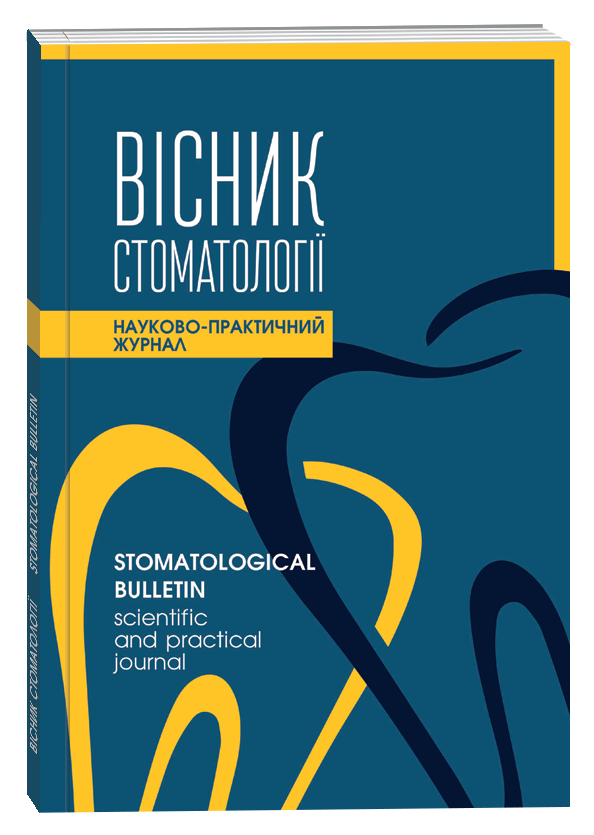PECULIARITIES OF PREVENTION AND TREATMENT OF CHANGES IN PERIODONTIC TISSUES IN CHILDREN LIVING IN ECOLOGICALLY POLLUTED REGIONS OF THE PRECARPATHIANS
DOI:
https://doi.org/10.35220/2078-8916-2021-42-4.8Keywords:
chronic catarrhal gingivitis, ecologically polluted areas, chlorhexidine dent, quercetin, reorganic changes of periodontiumAbstract
Purpose of the study. To study changes in periodontal tissues in children living in ecologically favorable conditions and in ecologically polluted regions of Prykarpattia, to compare comparative characteristics of periodontal changes, to increase the effectiveness of treatment of chronic catarrhal gingivitis in people living in ecologically favorable conditions and in ecologically polluted regions. Chlorhexidine-dent and quercetin. Research methods. We examined 60 patients with chronic catarrhal gingivitis living in ecologically stable conditions (Ivano-Frankivsk) (1 group of patients), 15 people with intact periodontium and 60 children with chronic catarrhal gingivitis living in the contaminated areas of Prykarpattia (Burshtyn) (2 groups of patients). All patients before treatment underwent a set of therapeutic measures that are recommended for the conventional treatment of patients with chronic catarrhal gingivitis. In groups 1a and 2a, patients were treated with chlorhexidine, calendula and chamomile infusion and 1% mefenamine paste. Patients in groups 1b and 2b were prescribed the drug quercetin (registration certificate №UA / 0119/01/01) 1 g, once a day application of gel, which is pre-applied to an individual silicone cap for 10 days and mouth baths with chlorhexidine-dent 3 times a day. day for 10 days. The clinical condition of periodontal tissues in children living in environmentally unfavorable conditions was assessed by the indicators of the hygienic index of IG, PMA, IR, Schiller-Pisarev test and digital characteristics of rheograms. In order to comparatively characterize the treatment methods, an index assessment of the quality before treatment was performed, after 3 months, 6 months, 12 months; study of rheographic parameters of periodontal tissues after 6 and 12 months. Scientific novelty. At the present stage, chlorhexidine-dent 0.12% and quercetin are used for the treatment of periodontal diseases in children living in environmentally unfavorable conditions, the state of hemodynamics in periodontal tissues is studied, rheographic parameters and their dynamics under the influence of treatment and prevention complex in children with chronic catarrhal gingivitis and evaluated the effectiveness of the developed treatment and prevention complex in children with chronic catarrhal gingivitis living in environmentally unfavorable conditions. Conclusions. The results showed a significant difference between clinical and laboratory parameters in patients of groups 1 and 2 (p <0.05). The use of quercetin and chlorhexidine-dent solution 0.12% in the complex treatment of patients with chronic catarrhal gingivitis provides a significant improvement in clinical parameters and laboratory characteristics of periodontal tissues in children living in different environmental conditions, and stimulates metabolic processes in periodontal tissues, reduces cyanosis, edema of periodontal tissues according to the results of rheography of periodontal tissues.
References
Кузенко Є.В., Романюк А.М. Запальні захворювання пародонта: патогенез та морфогенез : монографія. Суми. 2016. С. 30–42.
Гафар А. Запалення, захворювання пародонта та здоров’я організму. Современная стоматология. 2008. № 1. С. 60–61.
Львова Л. Микрофлора полости рта: актуальные клинические случаи Стоматолог. 2002. № 1. С. 8–10.
Безвушко Е.В. Особливості формування патології тканин пародонта в дітей, що проживають у різних екологічних умовах. Вісник стоматології. 2008. № 2. С. 97–101.
Гжегоцкий М.Р. Ксенобиотики в окружающей среде: физико-токсикологические основы системного подхода к обоснованию нормативов химической безопасности человека (обзор литературы и собственных исследований). Журнал АМН України. 2002. Т. 8, № 3. С. 575–590.
Kshirsagar A.V., Moss K.L., Elter J.R. Periodontal disesase is associated with general insufficiency in the Atherosclerosis Risk in Communities (ARIS) study Am. J. Kidney Dis. 2005. № 45 (4). С. 650–657.
Колесова Н.А. Морфологическая обьективизация состояния мягких тканей пародонта у детей г. Киева. Полтава, 2006. С. 112.
Самусев Р.П. Основи клинической мофрологии Москва: Оникс-21 века. Мир и образование. 2002. С. 368.
Борисенко А.В. Вплив захворювань пародонта на загальний стан організму. Здоров’я суспільства. 2013. № 1. С. 32–37.
Deckre Em1, Maier G, Axmann D, Brecx M, von Ohle C Effect of xylitol/chlorhexidine versus xylitol or chlorhexidine as single rinses on invitial biofilm formation of cariogenic streptococci. Quintessence Int. 2008. № 39(1). Р. 17–22.
Шманько В.В., Котик М.І., Микитів М.В. Сучасні підходи до лікування хвороб пародонта і слизової оболонки порожнини рота. Вісник наукових досліджень. 2015. № 4. С. 71–74.
Грудянов А.И., Стариков Н.А. Лекарственные средства, применяемые при заболеваниях пародонта. Пародонтология. 1998. № 2 (8). С. 6–17.
Гапонцев В.П. Медицинские аппараты на основе мощных полупроводниковых и волоконных лазеров. Квантовая электроника. 2002. № 32(11). С. 1003–1006.
Белоклицкая Г.Ф. Возможности антиоксидантной коррекции перекисного окисления липидов при заболеваниях пародонта разной тяжести. Современная стоматология. 2000. № 1. С. 38–41.
Makhlynets N. Histopathological changes of oral mucosa on the base of the complex treatment of patients with generalized periodontitis. Perspectives of world science and education: матеріали Х міжнародної науково-практичної конференції (Осака, 17–19 червня, 2020 р.). Осака, 2020. С. 47–56.
Заболотний Т.Д., Борисенко А.В., Марков А.В., Шилівський І.В. Генералізований пародонтит. Львів : ГалДент, 2011. 239 с.









